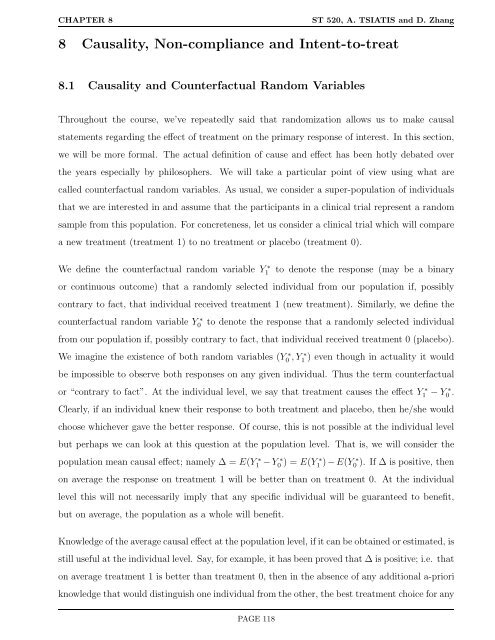ST 520 Statistical Principles of Clinical Trials - NCSU Statistics ...
ST 520 Statistical Principles of Clinical Trials - NCSU Statistics ...
ST 520 Statistical Principles of Clinical Trials - NCSU Statistics ...
Create successful ePaper yourself
Turn your PDF publications into a flip-book with our unique Google optimized e-Paper software.
CHAPTER 8 <strong>ST</strong> <strong>520</strong>, A. TSIATIS and D. Zhang<br />
8 Causality, Non-compliance and Intent-to-treat<br />
8.1 Causality and Counterfactual Random Variables<br />
Throughout the course, we’ve repeatedly said that randomization allows us to make causal<br />
statements regarding the effect <strong>of</strong> treatment on the primary response <strong>of</strong> interest. In this section,<br />
we will be more formal. The actual definition <strong>of</strong> cause and effect has been hotly debated over<br />
the years especially by philosophers. We will take a particular point <strong>of</strong> view using what are<br />
called counterfactual random variables. As usual, we consider a super-population <strong>of</strong> individuals<br />
that we are interested in and assume that the participants in a clinical trial represent a random<br />
sample from this population. For concreteness, let us consider a clinical trial which will compare<br />
a new treatment (treatment 1) to no treatment or placebo (treatment 0).<br />
We define the counterfactual random variable Y ∗<br />
1 to denote the response (may be a binary<br />
or continuous outcome) that a randomly selected individual from our population if, possibly<br />
contrary to fact, that individual received treatment 1 (new treatment). Similarly, we define the<br />
counterfactual random variable Y ∗<br />
0<br />
to denote the response that a randomly selected individual<br />
from our population if, possibly contrary to fact, that individual received treatment 0 (placebo).<br />
We imagine the existence <strong>of</strong> both random variables (Y ∗<br />
0<br />
∗ , Y ) even though in actuality it would<br />
be impossible to observe both responses on any given individual. Thus the term counterfactual<br />
or “contrary to fact”. At the individual level, we say that treatment causes the effect Y ∗<br />
1 − Y ∗<br />
0 .<br />
Clearly, if an individual knew their response to both treatment and placebo, then he/she would<br />
choose whichever gave the better response. Of course, this is not possible at the individual level<br />
but perhaps we can look at this question at the population level. That is, we will consider the<br />
population mean causal effect; namely ∆ = E(Y ∗<br />
1<br />
−Y ∗<br />
0<br />
1<br />
∗<br />
∗<br />
) = E(Y ) −E(Y ). If ∆ is positive, then<br />
on average the response on treatment 1 will be better than on treatment 0. At the individual<br />
level this will not necessarily imply that any specific individual will be guaranteed to benefit,<br />
but on average, the population as a whole will benefit.<br />
Knowledge <strong>of</strong> the average causal effect at the population level, if it can be obtained or estimated, is<br />
still useful at the individual level. Say, for example, it has been proved that ∆ is positive; i.e. that<br />
on average treatment 1 is better than treatment 0, then in the absence <strong>of</strong> any additional a-priori<br />
knowledge that would distinguish one individual from the other, the best treatment choice for any<br />
PAGE 118<br />
1<br />
0
















